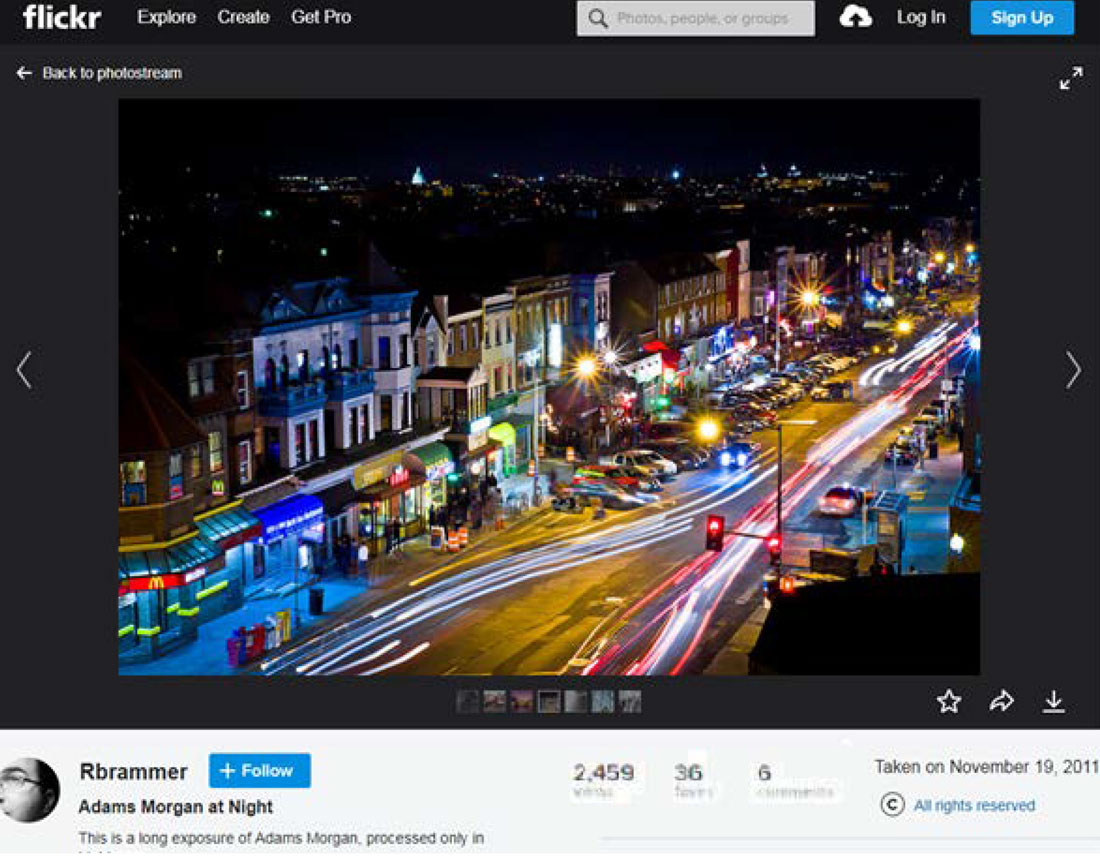
11 May Court of Appeals Throws Out Faulty Fair Use Verdict
On April 26, 2019 the Fourth Circuit Court of Appeals reversed a lower court finding of fair use in the case of photographer Russell Brammer versus Violent Hues Productions. The original ruling drew condemnation from artist advocates, since the lower court found that Violent Hues’ use of the photo was “transformative.” The worry was that the decision created a precedent that would define almost any use of copyrighted material as fair use, effectively gutting copyright protections for creators.
The original case came about when Violent Hues used Russell Brammer’s photograph of the DC neighborhood, Adams Morgan, without permission. A cropped version of the photograph was posted to a website for Violent Hues’ DC-based film festival, illustrating a page of neighborhood highlights for festival goers. Brammer contacted Violent Hues requesting a licensing fee and that the photograph be removed. The photograph was removed, but when no payment of the licensing fee was forthcoming, Brammer sued Violent Hues for copyright infringement.
The defense attorney argued that the copyright case should be dismissed because the use was a fair use, and therefore not infringing. The judge agreed, stating that Violent Hues’ use of the photograph was transformational, since the photographer’s intent in publishing the photo was promotional and expressive, whereas Violent Hues’ intent was informational. That conclusion was rejected by artist advocates. NPPA and ASMP filed an amicus brief (which the Guild joined); in it, they stated “By noting, then discarding, the creative elements of this photograph, this Court eviscerates the ability of any photograph to be entitled to copyright protection.”
The appellate court echoed that reasoning in their ruling:
Violent Hues’ sole claim to transformation is that its secondary use of the Photo provided film festival attendees with “information” regarding Adams Morgan. But such a use does not necessarily create a new function or meaning that expands human thought; if this were so, virtually all illustrative uses of photography would qualify as transformative. (emphasis ours)
Fair use is a doctrine in US copyright law that states some limited uses of copyrighted material are permitted without permission from the copyright owner. The use must be limited and “transformative”, such as criticism, commentary, or parody of the copyrighted work. The purpose of fair use is to balance First Amendment freedom of expression and the need to use copyrighted material for progress, with the economic incentive copyrights grant to the creators. In order for a use of a copyrighted work to be deemed “fair use,” the court considers four factors: the purpose and character of the use, the nature of the copyrighted work, the amount and substantiality of the portion used, and the effect of the use upon the potential market for or value of the copyrighted work.
The original District Court judgement had found that all four factors weighed in favor of fair use in Violent Hues use of Brammer’s photograph. The appellate ruling, however, reconsidered the use against the four factors, and found that none weighed in favor of a fair use defense. In fact, the judgement recognized that Violent Hues’ use of the photo doesn’t further the purpose of fair use:
[C]opyright law embodies a recognition that creative intellectual activity is vital to the well-being of society,” and fair use exists to “stimulate creativity and authorship” of derivative but new works. Pierre N. Leval, Toward a Fair Use Standard, 103 Harv. L. Rev. 1105, 1109 (1990). Violent Hues’ “informational” use of the Photo as a stock image does not further this intellectual objective because Violent Hues said nothing new through this use. Instead, allowance of Violent Hues’ defense would frustrate copyright’s central goal. If the ordinary commercial use of stock photography constituted fair use, professional photographers would have little financial incentive to produce their work.
At top of page: a screenshot of Russell Brammer’s photo of Adams Morgan on his Flckr page.
Photo © Russell Brammer, used with permission.
